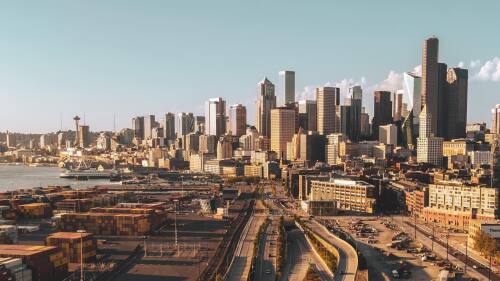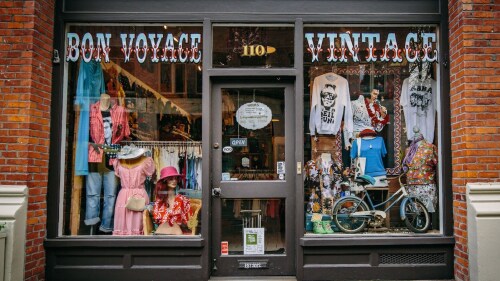Hey, Seattle 👋 Alina here. As some of you may know by now, I only moved to Seattle a few months ago, so there’s still quite a bit I’m learning about the city.
Even so, I don’t know that I’ve lived in too many other places where historical districts and sites were talked about so frequently, whether it was the recent concern over the Guild 45th Theater or the many detailed posts at Vanishing Seattle. It’s fascinating to hear about and, for those of you who’ve been around awhile, a great way to rediscover the city.
So, over the next few months, I’d like to take the time to explore Seattle’s eight historical districts together. I’ll give you some interesting nuggets of history and tell you what fun you can find there.
Ballard Avenue Landmark District
Let’s step back in time to the late 1800s.
Flashback ⏳
In 1887, Captain William Ballard began developing a 160-acre plot of land that would later become the neighborhood now bestowed with his name. The area’s easy access to the Puget Sound attracted the fishing industry, and settlers from Scandinavia soon moved into the area.
In 1890, Ballard became linked to Seattle by railcar and incorporated into the growing city. Ballard Avenue became a landmark district in 1976 to preserve street features that still remain from the neighborhood’s early days like horse hitching rings, original granite curbs + streetcar infrastructure.
Lay of the land now 🌳
The Ballard Avenue Landmark District currently encompasses the businesses on both sides of the street between NW Market St. + NW Dock Pl. There are ~28,000 residents living in Ballard, of which the median age is 34 years old — a hair below Seattle’s average of 35 years.
Digs for sale 🏡
- Bright, shiny townhouse | 3 BD, 3 BA | $1,050,000
- Modern townhouse with a rooftop patio | 3 BD, 3 BA | $1,150,000
- Sleek, spacious standalone home | 4 BD, 4 BA | $1,495,000
Nearby biz + things to do 📋
- The Splintered Wand | A dragon head attached to the wall of this wizard-themed bar will gaze upon you as you imbibe on a selection of absinthe + other magical concoctions.
- Ballard Farmers Market | Grab your fresh produce year-round — rain or shine.
- Miro Tea | Explore the 150 tea blends available for purchase, grab a cup at the shop’s cafe, or take one of the biz’s tea classes to learn more about the industry.
Pike Place Historical District
Pike Place Market was formed more than 100 years ago, but continues to be flooded with activity as one of Seattle’s most iconic landmarks and somewhere locals shop for high-quality local goods + produce.
Flashback ⏳
Pike Place Market was established by Seattle City Council in 1907 as a place where locals could buy their food directly from farmers and fishers. The first market day had just eight vendors, but they sold all of their goods fairly quickly on account of the 10,000 shoppers that showed up. By the end of the year, new buildings were already being constructed to house the 120 farmers that became regular tenants.
In 1963, a plan was proposed to demolish the market to make way for a “modernized” Pike Plaza. However, a major campaign to keep the area intact commenced and it was designated as a historical district in 1971 — effectively saving the oldest continuously running public market from demolition.
Lay of the land now 🌳
The Pike Place Historical District encompasses the entirety of the market and bleeds down towards the waterfront over Western Avenue. There aren’t many residences in this area, but of the ~5,800 folks who live in the Central Waterfront area, the median age is 35 — right on point with Seattle’s overall median of 35.
Digs for sale 🏡
- Sleek waterfront perch | 2 BD, 3 BA | $9,700,000
- Hidden nook steps from the action | 2 BD, 2 BA | $675,000
- Sky high loft | 2 BD, 2 BA | $2,280,000
Nearby biz + things to do 📋
- JarrBar | This tiny little bar feels like a well-kept secret. Grab a tin of fish and a Spanish margarita.
- Original Selfie Museum | Need some new content for the ‘gram? This museum has all of the backgrounds you’ll need — just bring your camera.
- Zig Zag Cafe | Perfect for a night cap or some local baked oysters.
Columbia City Landmark District
Columbia City, once a streetcar suburb fueled by a booming lumber industry, is now one of Seattle’s most diverse neighborhoods.
Flashback ⏳
Columbia City was born, much like Seattle, as a mill town in the late 1800s and became incorporated as its own city in 1893. However, it became annexed by Seattle after just thirteen years in 1907 (it’s a lot of work to run your own town). The town remained a business hub for years because of the electric railway that led to downtown Seattle.
Eventually, the railway was removed to pave Rainier Avenue in 1937 and the local economy suffered (a Great Depression doesn’t help anything). It became designated as a Landmark District in 1978, which encouraged rehabilitation of historic buildings and pedestrian-oriented businesses.
Lay of the land now 🌳
The Columbia City Landmark District is a small area that straddles Rainier Ave. S. in South Seattle. Within the district, there are an estimated 6,317 residents of which the median age is 38 (just a few notches above Seattle’s median age of 35). There are 23 different languages spoken in the area, with Vietnamese + African languages making up the highest percentage.
Digs for sale 🏡
- Cozy and bright family residence | 5 BD, 3 BA | $999,950
- Colorful home + a spacious kitchen | 4 BD, 4 BA | $1,999,880
- Century old home with modern finishes | 3 BD, 3 BA | $1,200,000
Nearby biz + things to do 📋
- Safari Njema | This Kenyan restaurant is known for having one of the best tilapia dishes in town.
- The Royal Room | The South Hudson Music Project is partnering with the venue for a Juneteenth celebration on Sunday with a performance by the Elnah Jordan Experience.
- Coffeeholic House | The Vietnamese coffee shop’s purple ube latte is Insta-famous + a total treat for the tastebuds.
Chinatown-International District
The Chinatown-International District bustles with activity and is well-known around the city for its excellent cuisine and vibrant public arts pieces.
Flashback ⏳
The community remains the only area in the continental US where Chinese, Japanese, Filipino, African American, and Vietnamese folks settled together and built one neighborhood.
Fun fact for ya — it’s actually home to two historic districts.The City of Seattle first established the International Special Review District in 1973 to “preserve the [...] unique Asian American character.” Ten years later, the Seattle Chinatown National Register Historic District was established within the first district, “testifying to the important contributions of [the district] on a national level.
Preservation efforts for this culturally rich district have been especially important alongside the many impacts of discrimination and segregation its seen throughout the years, as one of the few ethnic neighborhoods remaining in Seattle.
Lay of the land now 🌳
The Chinatown-International District, which occupies 23 acres near Pioneer Square, is currently home to about 7,000 residents. There are 17 different languages spoken in the district, with Mandarin/Cantonese and Vietnamese making up the highest percentage. The median resident age is 46, which skews above Seattle’s median of 35.
The area is well-known for its stunning Asian-influenced architecture and artworks, diverse (and delicious) cuisine, and rich cultural events.
Digs for sale 🏡
- Condo with stunning city views | 2 BD, 2 BA | $640,000
- Penthouse loft with exposed brick | 2 BD, 2 BA | $1,425,000
- Loft with wraparound windows | 2 BD, 2 BA | $999,000
Nearby biz + things to do 📋
- Wing Luke Museum | The current Gerard Tsutakawa: Stories Shaped in Bronze exhibit guides attendees through the local sculptor’s works and cultural significance.
- Happy Lamb Hot Pot | Dunk and cook your choice of meats + vegetables in the warm, brothy goodness.
Harvard-Belmont Landmark District
Harvard-Belmont is a quiet, but distinguished neighborhood situated on the west slope of Capitol Hill. Its founding goes all the way back to the early 1900s, but it only became a historical district in 1980.
Flashback ⏳
The Harvard-Belmont neighborhood has attracted some of Seattle’s most influential and wealthy families + individuals. The first among them was Horace Chapin Henry, a railroad builder who settled down in 1901. Behind him followed names like David Denny, Sarah Yesler, and John Leary.
Because these early residents could afford to hire their own highly-regarded architects, Harvard-Belmont’s buildings have a noticeable lack of consistency in style — ranging from Tudor to Northwest Regional. This affluence is the same reason the neighborhood never became a “streetcar suburb” — families could buy the newly-invented automobile.
Lay of the land now 🌳
The landmark district encompasses 34 acres within Capitol Hill and its 98102 zip code. The hilly topography of the area lends itself to stunning views of Lake Union, the Olympic Mountains, and the Puget Sound. The neighborhood also bumps up directly against Volunteer Park and the cemetery where movie star Bruce Lee is buried.
The 98102 zip code — which includes Portage Bay + East Lake, too — is home to about 20,000 Seattleites and 14,000 housing units
H3
. The median age is 33, which skews just underneath Seattle’s average at 35.
Digs for sale 🏡
- Remodeled residence with English garden | 4 BD, 4 BA | $4,150,000
- High-ceilinged historic home with period details | 5 BD, 7 BA | $4,895,000
- Sam Hill House featuring unobstructed lake + mountain views | 5 BD, 9 BA | $16,000,000
Nearby biz + things to do 📋
- Seattle Asian Art Museum | The Be/longing exhibit highlights contemporary works by 12 artists from across Asia
- Finch and Pine | Friendly neighborhood cafe with a well-rounded brunch
- Macrina Bakery | Quaint bakery that has marble counters filled with breads, pastries, and other treats
Sand Point Naval Air Station Landmark District
The Sand Point Naval Air Station Landmark District sits tucked away in Northeast Seattle, sandwiched directly between Ravenna and Lake Washington. You may know the area for being near Magnuson Park, but it’s had a pretty direct influence on our local aviation industry.
Flashback ⏳
Ground was first broken on the naval station (then outside city limits) in 1920 following the end of World War I. Not only is Sand Point a testing site for some of the original Boeing models, but in 1924, it was also the beginning and ending point of the first flights around the world.
It hit its peak military activity in 1945 when the base hosted more than 4,600 Navy, Marine Corps, and civilian folks — and achieved its landmark status in 2011.
Lay of the land now 🌳
The landmark district encompasses 89 acres next to the shore of Lake Washington — with the National Oceanic and Atmospheric Administration (NOAA) Western Regional Center and Magnuson Park as neighbors.
Neighboring Ravenna is where many families hoping to live close to Sand Point make their homes. Of the 3,490 total Ravenna households, about 77% stays in the same house as the year before — and the median age is 30 years old, skewing lower than Seattle’s median of 35 (about half of the households are made up of families).
Digs for sale 🏡
- Quiet residence with rooftop deck | 3 BD, 2 BA | $999,950
- Brand new, hand-crafted home | 5 BD, 5 BA | $2,895,000
- Cozy Cape Cod Cottage | 4 BD, 3 BA | $1,225,000
Nearby biz + things to do 📋
- PCC Market View Ridge | Seattle’s largest grocery co-op is conveniently located
- Sand Point Country Club | Practice your long game, take a swim, or enjoy some tennis
- Top Pot Doughnuts | No need to worry about plans for breakfast
Fort Lawton Landmark District

The Fort Lawton Landmark District includes old army building, such as these band barracks. | Photo by @kennethbrownpictures
The district sits nestled in the north end of town next to Magnolia, a serene neighborhood perfectly tucked away from the buzz of downtown and Queen Anne. Its rich history includes lots of military activity — and Magnolia Bluff’s unfortunate namesake mistake.
Flashback
Our story begins in 1857 when a surveyor named Lt. George Davidson came across the area and mistook the bluff’s madrona trees for magnolias (which may be acceptable if you only look at the leaf shape).
In 1896, US Secretary of War Daniel S. Lamont chose this spot to protect Seattle and south Puget Sound from naval attacks because of its strategic view into Elliott Bay and the sound. In 1900, the artillery base opened and soon transformed into an infantry training site. It would operate as such until 2011.
The lay of the land now
The Fort Lawton Landmark District itself only covers the former base. However, the old Officer Homes, nestled right in the middle of Discovery Park, went on the market only as recently as 2016. Another sold just this past year — and it’s gorgeous, of course.
As for Magnolia, the neighborhood is made up of approximately 9,883 households where 84.6% of the population has stayed in the same house as the year before. The median age of the Magnolia resident is 41 years old and 60.8% of households have families.
Digs for sale
- Once in a lifetime ocean overlook | 3 BD, 5 BA | $5,639,000
- Livingroom made for sunrises | 3 BD, 3 BA | $985,000
- Condo with a 5-piece bathroom | 2 BD, 2 BA | $585,000
Nearby biz + things to do
- Discovery Park | The largest city park with 534 acres of natural area
- Dirty Couch Brewing | This local brewery keeps its focus on its sours and wild ales
- West Point Lighthouse | A Victorian era beacon that adds wistful, vintage vibes to the beach
Pioneer Square Preservation District
Those who find themselves wandering through the streets of Pioneer Square on their way back to their car or public transit after a Seahawks or Mariners game will be quite familiar with the neighborhood’s stunning brick buildings and bustling streets. But let’s take a closer look at the eighth historic district in our walkthrough.
Flashback ⏳
Just in case its beautiful architecture didn’t give it away, Pioneer Square actually marks the site of Seattle’s original downtown. It was chosen by settlers in 1852 as one of the only areas that was flat enough for construction, while still being close to the water.
On June 6, 1889, 25 blocks of the mostly wooden structures burned down in the Great Seattle Fire — however, because the local economy was strong, it was easy for the city to rebuild on top of the destruction. The famous Underground Seattle highlights many of the former sites and is still open to tours.
Pioneer Square was established as a Preservation District in 1970 to protect what is one of the US’s best surviving collection of Romanesque Revival urban architecture.
Lay of the land now 🌳
Pioneer Square is one of Seattle’s largest historical districts and encompasses several blocks between S. Royal Brougham Way to the south, Columbia Street to the north, Alaskan Way to the west, and Fifth Avenue to the east.
Approximately 4,300 people call the area home, with a median age of 44 — 11 years higher than Seattle’s overall median age of 35.
Digs for sale
Though not known for being residential, there are some occasional hidden gems.
- Penthouse loft with private outdoor space | 2 BR, 2 BA | $1,425,000 (listed in January)
- Updated, light-filled condo overlooking courtyard | 1 BR, 1 BA | $398,500 (listed in January)
- Exposed brick loft in historic building | 1 BR, 2 BA | $738,200 (listed in December)
Walkable biz + things to do
- Smith Tower | The oldest skyscraper in the city has great views + cocktails at the observatory
- Nirmal’s | Some of the best Indian food in the city with an approachable, upscale atmosphere
- Bill Spiedel’s Underground Tour | A taste of Seattle history, with a look at what lies beneath those old sidewalks
- Cafe Nordo | Immersive dinner theater includes anything from murder mysteries to “Alice in Wonderland” takes
- Davidson Galleries | One of several art galleries to check out around a tree-lined block



















